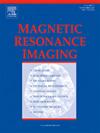Acquisition and reconstruction with motion suppression DWI in total knee arthroplasty for metal artifact reduction: An in-vitro and in-vivo investigation
IF 2
4区 医学
Q2 RADIOLOGY, NUCLEAR MEDICINE & MEDICAL IMAGING
引用次数: 0
Abstract
Background
Applying diffusion-weighted imaging (DWI) to identify periprosthetic infectious complications continues to present challenges in patients with total knee arthroplasty (TKA). This study aimed to investigate the feasibility of DWI combined with acquisition and reconstruction with motion suppression (ARMS-DWI) in TKA.
Methods
ARMS-DWI with multiple bandwidths (300, 500, 700 Hz/px), voxel sizes (1.2*1.2*3, 1.5*1.5*3, 1.8*1.8*3 mm3) and B-values (0–400, 0–600, 0–800 s/mm2) were obtained in vitro. Qualitative scores (QS) of image quality and artifacts severity and quantitative measurements of maximum artifact width (MAW), maximum artifact area (MAA), signal-to-noise ratio (SNR) and coefficients of variation (CV) were assessed. Seventeen TKA patients underwent ARMS-DWI with the optimal parameters, obtained from aforementioned assessments. The ADC values generated from ARMS-DWI and echo-planar DWI were compared.
Results
ARMS-DWI with 700 Hz/px bandwidth showed minimum artifacts with the highest QS, and the lowest MAW, MAA, CV, and SNR (all p ≤ 0.009). An uptrend of QS and a downtrend of MAW, MAA, SNR, and CV were observed with the decrease in voxel sizes. ARMS-DWI with 800 s/mm2 B-value yield the highest MAW and MAA and the lowest QS (all p ≤ 0.012). No significant difference in QS and MAW were found between 400 and 600 s/mm2 (both p > 0.05). ADC values showed no significant differences (p = 0.056–0.851). The optimal ARMS-DWI protocol-700 Hz/px bandwidth, 1.2*1.2*3 mm3 voxel size and 600 s/mm2 B-value-achieved acceptable artifacts and soft-tissue visualization in TKA.
Conclusions
ARMS-DWI with the optimal parameters could be applied in TKA patients to detect periprosthetic infections.
运动抑制DWI在全膝关节置换术中获取和重建金属伪影复位:一项体外和体内研究。
背景:在全膝关节置换术(TKA)患者中,应用弥散加权成像(DWI)识别假体周围感染性并发症仍然是一个挑战。本研究旨在探讨DWI联合运动抑制采集重建(ARMS-DWI)在TKA中的可行性。方法:体外获得多个带宽(300、500、700 Hz/px)、体素大小(1.2*1.2*3、1.5*1.5*3、1.8*1.8*3 mm3)和b值(0-400、0-600、0-800 s/mm2)的ARMS-DWI。评估图像质量和伪影严重程度的定性评分(QS)和最大伪影宽度(MAW)、最大伪影面积(MAA)、信噪比(SNR)和变异系数(CV)的定量测量。17例TKA患者接受了ARMS-DWI检查,参数从上述评估中获得最佳参数。比较了arm -DWI和回波平面DWI产生的ADC值。结果:带宽为700 Hz/px的ARMS-DWI伪像最小,QS和CV最高,MAW、MAA和SNR最低(p均 ≤ 0.009)。随着体素大小的减小,QS呈上升趋势,MAW、MAA、SNR和CV呈下降趋势。当b值为800 s/mm2时,ARMS-DWI的MAW和MAA最高,QS最低(p均 ≤ 0.012)。400和600 s/mm2之间的QS和MAW无显著差异(p均为 > 0.05)。ADC值差异无统计学意义(p = 0.056-0.851)。最佳ARMS-DWI协议-700 Hz/px带宽,1.2*1.2*3 mm3体素大小和600 s/mm2 b值-在TKA中实现了可接受的伪影和软组织可视化。结论:具有最佳参数的ARMS-DWI可用于TKA患者假体周围感染的检测。
本文章由计算机程序翻译,如有差异,请以英文原文为准。
求助全文
约1分钟内获得全文
求助全文
来源期刊

Magnetic resonance imaging
医学-核医学
CiteScore
4.70
自引率
4.00%
发文量
194
审稿时长
83 days
期刊介绍:
Magnetic Resonance Imaging (MRI) is the first international multidisciplinary journal encompassing physical, life, and clinical science investigations as they relate to the development and use of magnetic resonance imaging. MRI is dedicated to both basic research, technological innovation and applications, providing a single forum for communication among radiologists, physicists, chemists, biochemists, biologists, engineers, internists, pathologists, physiologists, computer scientists, and mathematicians.
 求助内容:
求助内容: 应助结果提醒方式:
应助结果提醒方式:


